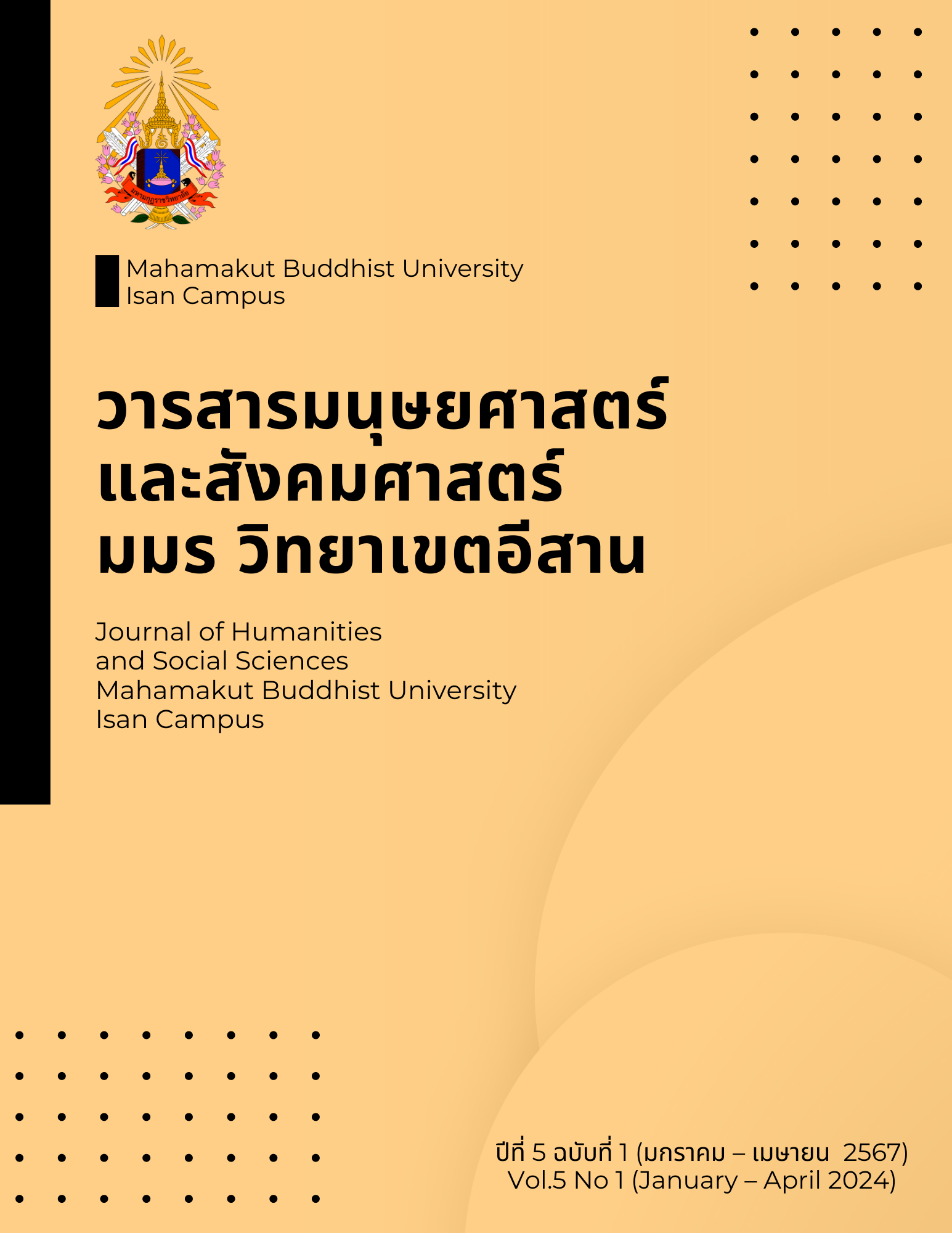GUIDELINES FOR IDENTITY COMMUNICATION OF CREATIVE WOVEN FABRICS TOURISM COMMUNITY IN PA SANG DISTRICT, LAMPHUN PROVINCE
Keywords:
Community-Based Tourism, Creative Tourism, Identity Communication, Woven FabricAbstract
The objectives of this research were as follows: 1) to study a participatory conservation model for woven fabric and stucco work; 2) to assess the potential for designing woven fabric and stucco work at the community level; and 3) to propose guidelines for innovatively communicating the identity and narratives associated with woven fabric and stucco work. The study employed a mixed methods approach, integrating both quantitative and qualitative research methodologies. The research was conducted in Pa Sang District, Lamphun Province. The quantitative research sample comprised 250 tourists and entrepreneurs, selected using a simple random sampling method. Additionally, 25 key informants, including teachers specializing in weaving and stucco work, entrepreneurs, community leaders, and representatives from government agencies, were selected based on a purposive sampling method. The research tools utilized included questionnaires, interview forms, and focus group discussions. Quantitative data were analyzed using basic statistical methods, while for qualitative research, content was synthesized and descriptive reports were written. The research results revealed as follows: 1). A participatory conservation model for woven fabric and stucco work had been passed down through generations and had evolved into a distinctive skill. This led to the creation of unique community identity products, using local materials and production techniques that result in items that are practical, functional, aesthetically pleasing, captivating, innovative, and attractive. There was a strong spirit of cooperation among communities in producing these pieces, and annual community cultural and product exhibition activities were organized. 2). The potential for designing woven fabric and stucco work at the community level according to tourists’ opinions was at a high level. This was attributed to effective village management, which led to the establishment of a community-based economy providing sustainable income, and fostered a welcoming atmosphere among the community members. Moreover, the opinions of entrepreneurs were at the highest level. It was evident that the community's traditional lifestyle and cultural practices are significant attractions for tourists, and the community boasts exceptional craftsmanship. 3). Guidelines for innovatively communicating the identity and narratives associated with woven fabric and stucco work should be done through new marketing communication concepts (4E) including 1) Experience, creating memorable experiences, 2) Exchange, adding value for products and services, 3) Everywhere, ensuring easy accessibility through various channels, and 4) Evangelism, transforming one-time customers into loyal patrons. This could be achieved through the creation of two short video clips: 1) Hand weaving, heart weaving, Lamphun cloth 2) Women weaving Lamphun cloth
References
กลุ่มงานยุทธศาสตร์และข้อมูลพัฒนาจังหวัดลำพูน. (2564). แผนพัฒนาจังหวัดลำพูน พ.ศ. 2566-2570 (ฉบับ ทบทวน พ.ศ. 2567. จังหวัดลำพูน
กิตติพงษ์ เกียรติวิภาค. (2555). การศึกษาและพัฒนาการนำผ้าฝ้ายทอมือมาประยุกต์ใช้ในการสร้างสรรค์เพื่อ พัฒนาผลิตภัณฑ์ กรณีศึกษา : กลุ่มหมู่บ้านผ้าฝ้ายทอมือบ้านดอนหลวง อำเภอป่าซาง จังหวัด ลำพูน. รายงานการวิจัย. คณะศิลปกรรมศาสตร์ มหาวิทยาลัยธรรมศาสตร์.
ประภัสสร แสนไชย. (2554). กระบวนการถ่ายทอดความรู้หัตถกรรมผ้าฝ้ายทอมือของชุมชนบ้านดอนหลวง จังหวัดลำพูน. วิทยานิพนธ์ มหาวิทยาลัยเชียงใหม่
ปิยารัช เชยวัดเกาะ. (2546). โครงสร้างทางการตลาดของผลิตภัณฑ์สิ่งทอบ้านดอนหลวง จังหวัดลำพูน.
วิทยานิพนธ์ มหาวิทยาลัยเชียงใหม่
มานพ ชุ่มอุ่น. (2555). การจัดการความรู้เพื่อพัฒนาธุรกิจชุมชนในผลิตภัณฑ์ผ้าฝ้ายทอมือ กรณีศึกษา
: กลุ่มผ้าฝ้ายทอมือบ้านดอนหลวง ตำบลแม่แรง อำเภอป่าซาง จังหวัดลำพูน. รายงานการวิจัย คณะวิทยาการจัดการ มหาวิทยาลัยราชภัฎเชียงใหม่.
ฤทัยรัตน์ แผนทอง. (2552). การเพิ่มผลผลิตผลิตภัณฑ์ผ้าฝ้ายทอมือของกลุ่มทอผ้าบ้านแม่แรง ตำบลแม่แรง อำเภอป่าซาง จังหวัดลำพูน. เชียงใหม่ : มหาวิทยาลัยเชียงใหม่.
วลัยลักษณ์ อริยสัจจเวศิน. (2552). การจัดการความรู้ภูมิปัญญาท้องถิ่น: กรณีศึกษาผ้าจกคูบัว ตำบลคูบัว อำเภอเมือง จังหวัดราชบุรี. รายงานการวิจัยสาขาวิชาพัฒนาศึกษา มหาวิทยาลัยศิลปากร.
วิกานดา ศรีกอก. (2549). ปัจจัยที่มีอิทธิพลต่อการตัดสินใจซื้อผลิตภัณฑ์แปรรูปจากผ้าฝ้ายทอมือของหมู่บ้าน
อุตสาหกรรมเพื่อการท่องเที่ยวบ้านดอนหลวง อำเภอป่าซาง จังหวัดลำพูน. มหาวิทยาลัยเชียงใหม่.
วีระ แก่นเพชร. (2564). แนวทางการพัฒนาการท่องเที่ยวของประเทศไทยเพื่อสร้างมูลค่าเพิ่มในยุคดิจิทัล.
วารสารนวัตกรรมและการจัดการ. 6(1), 148-160.
ปริญญา นาคปฐม และสิทธิชัย สวัสดิ์แสน. (2565). แนวทางการพัฒนาการท่องเที่ยวอย่างยั่งยืนจังหวัด นครนายกภายหลังสถานการณ์โควิด-19. วารสารเพื่อการพัฒนาการท่องเที่ยวสู่ความยั่งยืน. 4(2),
-55.
สคราญนิตย์ เล็กสุทธิ์. (2556). การสืบสานภูมิปัญญาท้องถิ่นผ้าฝ้ายทอมือที่สอดคล้องกับหลักพุทธธรรมของ กลุ่มผ้าฝ้ายทอมือบ้านหนองเงือก ตำบลแม่แรง อำเภอป่าซาง จังหวัดลำพูน.
รายงานการวิจัย สำนักงานกองทุนสนับสนุนการวิจัย.
สมบัติ สิงฆราช (2554). การพัฒนากระบวนการผลิตของกลุ่มผู้ผลิตผ้าฝ้ายทอมือ กรณีศึกษา : กลุ่มทอฝ้าย บ้านดอนหลวง ตำบลแม่แรง อำเภอป่าซาง จังหวัดลำพูน. เชียงใหม่ : คณะวิทยาการจัดการ มหาวิทยาลัยราชภัฎเชียงใหม่
สุธีมนต์ ทรงศรีโรจน์. (2559). ปัจจัยที่ส่งผลต่อการจัดการองค์ความรู้ภูมิปัญญาท้องถิ่น กรณีศึกษา:
หมู่บ้านดอนหลวง ตำบลแม่แรง อำเภอป่าซาง จังหวัดลำพูน. รายงานการวิจัย คณะ
บริหารธุรกิจและศิลปะศาสตร์. มหาวิทยาลัยเทคโนโลยีราชมงคลล้านนา เชียงใหม่.
วารสารราชมงคลล้านนา, 4(1),
สุริยา สนธิ. (2550). ภูมิปัญญาพื้นบ้านในการจัดการด้านอาชีวอนามัยและความปลอดภัยในการทำงานทอ 4 ผ้า กลุ่มสตรีทอผ้าบ้านดอนหลวง จังหวัดลำพูน. เชียงใหม่: มหาวิทยาลัยเชียงใหม่.
อนงนาฏ อุ่นเรือน. (2557). การศึกษาสภาพการดำเนินงานด้านการจัดการของวิสาหกิจชุมชน กลุ่ม
ผลิตภัณฑ์จากผ้าฝ้ายทอมือ ตำบลแม่แรง อำเภอป่าซาง จังหวัดลำพูน. รายงานการวิจัย
สาขาวิชาบริหารธุรกิจ. บริหารธุรกิจมหาบัณฑิต. มหาวิทยาลัยแม่โจ้.
อโณทัย งามวิชัยกิจ. (2566). จริยธรรมการสื่อสารการตลาดดิจิทัลของผู้มีอิทธิพลเพื่อแสวงหาแนวทาง
การสื่อสารที่สมดุลระหว่างการตลาดอย่างสร้างสรรค์และการโน้มน้าวสังคม ด้วยประโยชน์ส่วนบุคคล. วารสารบริหารธุรกิจอุตสาหกรรม. 5(2), 51-65.
Taro Yamane. (1973). Statistics: an introductory analysis. New York: New York: Harper & Row.



